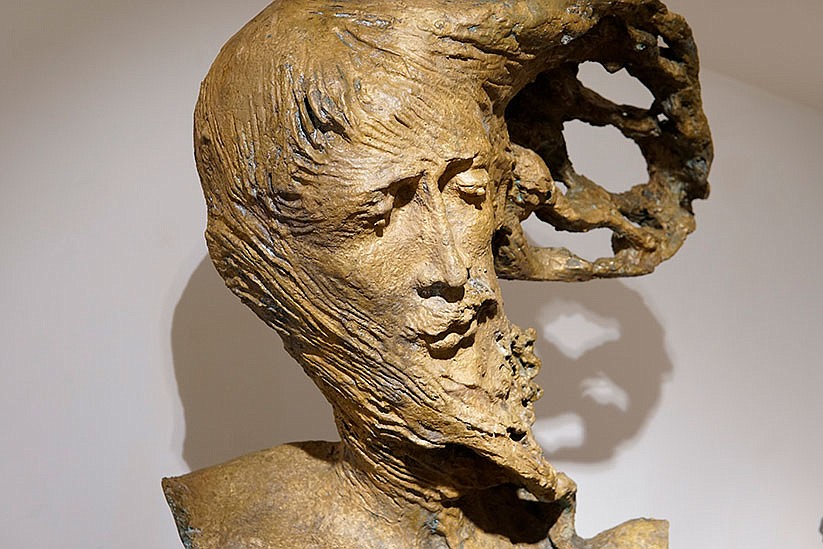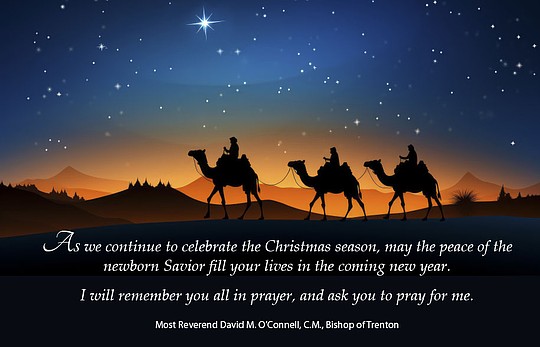Over the Pope's shoulder: An 'explosion' of spirituality in bronze
April 27, 2023 at 7:16 p.m.

The massive sculpture, nearly 66 feet wide and 23 feet tall, is the largest project realized by a single artist in the Vatican since Michelangelo painted the Sistine Chapel in the 16th century.
PHOTO GALLERY: Spirituality in Bronze
Millions of pilgrims traveling to Rome have seen what Father Timothy Verdon, a prominent art historian, called "the best-known post-conciliar work" in the Vatican, but it solicits mixed reviews.
When a photo of the sculpture was posted in online art forums earlier this year, some commentors responded that the piece looked "creepy" and "demonic." In 2022, a viral tweet depicting the sculpture asked: "Is this a normal thing the Pope stands in front of?"
The sculpture, titled "Resurrection," was partially inspired by the violence and chaos of the 1945 nuclear bombing of Hiroshima, Japan. The artist believed depicting a nuclear explosion would represent a powerful testimony of Christ's victory over even the most extreme forms of death and destruction as well as the moment when the material, through its annihilation, becomes immaterial.
The story of how Pericle Fazzini, the sculptor, came to create such a striking work is told in an exhibit at Rome's Carlo Bilotti Museum to mark the 110th anniversary of Fazzini's birth.
[[In-content Ad]]
After the Second World War, Fazzini's work combined his spiritual inclination with a strong sense of civic duty.
"Executed," completed in 1946, represents an Italian resistance fighter killed by a firing squad; the fighter's sinking body evokes that of Jesus in Michelangelo's "Pietà."
"His anti-fascism came from his Catholicism," said Alessandro Masi, an art historian and curator of the Rome exhibit. "He never fought with the resistance, but as an artist he represented (resistance fighters) not as war heroes, but as martyrs killed by the Nazis and fascists, as new Christs."
As his work gained notice, its spiritual dimension was recognized, and the sculptor began producing pieces for the Vatican, such as the tabernacle for the chapel of Secretariat of State, and a basin for the blessing of holy water in St. Peter's Basilica.
The sculptor eventually developed a "deep friendship "with St. Paul VI, who would invite artists to the Vatican for dinner, Masi told Catholic News Service. The Pope was "deeply convinced that that the mission of artists in the modern era was an evangelical one, and that the power of imagery could help in this mission."
That conviction led the Pope to search for an artist to build a work for the Vatican audience hall, which he commissioned in 1964. The following year, Fazzini was in talks with the Vatican about creating a large sculpture for the audience hall, although its architect, Pier Luigi Nervi, protested any additions that would alter the space within his building.
It wasn't until the Pope personally intervened in 1972 that Fazzini received the commission and began work on the piece. The resulting sculpture, "Resurrection," would become the "synthesis of his life's work," said Masi.
In his personal notes, Fazzini wrote that it was while waiting for a meeting at the Vatican to discuss the sculpture that he had an idea of "resurrecting Christ from a Garden of Gethsemane rocked by a nuclear explosion."
It is precisely that "explosion" and the "decomposition" of substance surrounding the Risen Christ that demonstrates Fazzini's "search for spirit in the material," Masi said.
"To him, the material world is not just material, but God is there," he said, "and the more the material world breaks down and becomes minute, the more one can see God in the particular."
While "Resurrection" attempts to convey Christ in embedded in the universe, "it is a universe that is turning into stardust," noted Masi.
St. John XXIII published his encyclical "Pacem in Terris" ("Peace on Earth"), calling for the banning of nuclear weapons, less than 10 years before Fazzini began work on "Resurrection." Fazzini was not making a political statement with the sculpture, Massi said, but chose to depict a nuclear explosion since it is in that moment that the material world "erupts" and "becomes atomized."
"His question was, how to atomize faith? How can I show that faith participates in the material of the universe? Because God is the material of the universe," he said.
The exhibit in Rome showcases early sketches and models of the bronze sculpture that stands today in the Paul VI audience hall, named after the saint who commissioned the hall and the artwork that adorns it. Fazzini's drawings and small busts in the exhibit demonstrate that, for the artist, the main objective of the sculpture was to emphasize Christ's victory over death and God's intertwined relationship with the physical world he created.
The sculpture was inaugurated shortly after St. Paul VI's birthday in 1977.
"Finally," Masi said, Fazzini had a "work that represented his lifelong aspiration of representing Christ."
Related Stories
Thursday, January 01, 2026
E-Editions
Events
The massive sculpture, nearly 66 feet wide and 23 feet tall, is the largest project realized by a single artist in the Vatican since Michelangelo painted the Sistine Chapel in the 16th century.
PHOTO GALLERY: Spirituality in Bronze
Millions of pilgrims traveling to Rome have seen what Father Timothy Verdon, a prominent art historian, called "the best-known post-conciliar work" in the Vatican, but it solicits mixed reviews.
When a photo of the sculpture was posted in online art forums earlier this year, some commentors responded that the piece looked "creepy" and "demonic." In 2022, a viral tweet depicting the sculpture asked: "Is this a normal thing the Pope stands in front of?"
The sculpture, titled "Resurrection," was partially inspired by the violence and chaos of the 1945 nuclear bombing of Hiroshima, Japan. The artist believed depicting a nuclear explosion would represent a powerful testimony of Christ's victory over even the most extreme forms of death and destruction as well as the moment when the material, through its annihilation, becomes immaterial.
The story of how Pericle Fazzini, the sculptor, came to create such a striking work is told in an exhibit at Rome's Carlo Bilotti Museum to mark the 110th anniversary of Fazzini's birth.
[[In-content Ad]]
After the Second World War, Fazzini's work combined his spiritual inclination with a strong sense of civic duty.
"Executed," completed in 1946, represents an Italian resistance fighter killed by a firing squad; the fighter's sinking body evokes that of Jesus in Michelangelo's "Pietà."
"His anti-fascism came from his Catholicism," said Alessandro Masi, an art historian and curator of the Rome exhibit. "He never fought with the resistance, but as an artist he represented (resistance fighters) not as war heroes, but as martyrs killed by the Nazis and fascists, as new Christs."
As his work gained notice, its spiritual dimension was recognized, and the sculptor began producing pieces for the Vatican, such as the tabernacle for the chapel of Secretariat of State, and a basin for the blessing of holy water in St. Peter's Basilica.
The sculptor eventually developed a "deep friendship "with St. Paul VI, who would invite artists to the Vatican for dinner, Masi told Catholic News Service. The Pope was "deeply convinced that that the mission of artists in the modern era was an evangelical one, and that the power of imagery could help in this mission."
That conviction led the Pope to search for an artist to build a work for the Vatican audience hall, which he commissioned in 1964. The following year, Fazzini was in talks with the Vatican about creating a large sculpture for the audience hall, although its architect, Pier Luigi Nervi, protested any additions that would alter the space within his building.
It wasn't until the Pope personally intervened in 1972 that Fazzini received the commission and began work on the piece. The resulting sculpture, "Resurrection," would become the "synthesis of his life's work," said Masi.
In his personal notes, Fazzini wrote that it was while waiting for a meeting at the Vatican to discuss the sculpture that he had an idea of "resurrecting Christ from a Garden of Gethsemane rocked by a nuclear explosion."
It is precisely that "explosion" and the "decomposition" of substance surrounding the Risen Christ that demonstrates Fazzini's "search for spirit in the material," Masi said.
"To him, the material world is not just material, but God is there," he said, "and the more the material world breaks down and becomes minute, the more one can see God in the particular."
While "Resurrection" attempts to convey Christ in embedded in the universe, "it is a universe that is turning into stardust," noted Masi.
St. John XXIII published his encyclical "Pacem in Terris" ("Peace on Earth"), calling for the banning of nuclear weapons, less than 10 years before Fazzini began work on "Resurrection." Fazzini was not making a political statement with the sculpture, Massi said, but chose to depict a nuclear explosion since it is in that moment that the material world "erupts" and "becomes atomized."
"His question was, how to atomize faith? How can I show that faith participates in the material of the universe? Because God is the material of the universe," he said.
The exhibit in Rome showcases early sketches and models of the bronze sculpture that stands today in the Paul VI audience hall, named after the saint who commissioned the hall and the artwork that adorns it. Fazzini's drawings and small busts in the exhibit demonstrate that, for the artist, the main objective of the sculpture was to emphasize Christ's victory over death and God's intertwined relationship with the physical world he created.
The sculpture was inaugurated shortly after St. Paul VI's birthday in 1977.
"Finally," Masi said, Fazzini had a "work that represented his lifelong aspiration of representing Christ."










